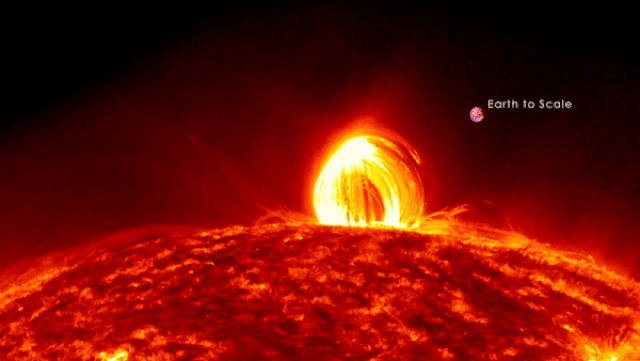
Coronal rain is created by plasma that expands up a magnetic loop that extends from the sun's surface. The plasma gathers at its peak, far from the heat source and, as it cools, condenses. Gravity then pulls the plasma back down the loop.
Astronomers have detected "plasma rain" pouring down over the solar surface, which may explain why the sun's outer atmosphere is so much hotter than the star's surface.
Recent NASA observations revealed coronal rain in a smaller, previously overlooked kind of magnetic loop on the sun, according to a statement from NASA. This rain consists of large droplets of hot plasma that fall from the sun's outer atmosphere (the corona) down toward the star's surface.
The new data, collected using high-resolution telescopes mounted on NASA's Solar Dynamics Observatory, showed that coronal rain works similarly to rain on Earth — with a few exceptions.
Related: The Sun Isn't Silent — Hear Its Song in New Observatory Data
Compared to rain on Earth, plasma rain on the sun is millions of degrees Fahrenheit hotter. Also, plasma, which is an electrically charged gas, doesn't pool like water on Earth. Instead, the plasma traces the magnetic field lines, or loops, that emerge from the sun's surface, according to the statement.
In addition, the researchers found that plasma where the magnetic loops attach to the sun's surface is superheated, reaching over 1.8 million degrees Fahrenheit (1 million degrees Celsius). This superhot plasma expands up the loop and gathers at the structure's peak. As the plasma cools, it condenses, and gravity pulls it back down the loop, creating coronal rain, according to the statement.
Previously, researchers had been searching for signs of coronal rain in larger, closed-magnetic-loop features known as helmet streamers, which extend millions of miles from the sun's surface. Researchers had targeted these features because the streamers are believed to be one source of slow solar wind — the stream of plasma and particles that emanates from the sun.
"These loops were much smaller than what we were looking for," Spiro Antiochos, a co-author on the new study and a solar physicist at NASA's Goddard Space Flight Center in Greenbelt, Maryland, said in the statement. "So that tells you that the heating of the corona is much more localized than we were thinking."
Therefore, the researchers' findings, published April 5 in The Astrophysical Journal Letters, shed light on the source of slow solar wind, as well as the heating process of the corona.
"If a loop has coronal rain on it, that means that the bottom 10% of it, or less, is where coronal heating is happening," Emily Mason, co-author of the study and a graduate student at The Catholic University of America in Washington, D.C., said in the statement.
The researchers identified raining loops that were about 30,000 miles (48,000 kilometers) high — a mere 2% the height of some of the helmet streamers the team originally sought, according to the statement.
"We still don't know exactly what's heating the corona, but we know it has to happen in this layer," Mason said.
The new findings also identified a possible link between the smaller magnetic loops and slow solar wind. Specifically, the team's observations show that coronal rain can also develop on open magnetic field lines, rather than only closed loops, as researchers had previously thought. One end of these open magnetic field lines leads out into space, where plasma could escape into the solar wind, according to the statement.
The researchers plan to study the smaller magnetic loop structures further using NASA's Parker Solar Probe, which launched in 2018 and has already traveled closer to the sun than any other spacecraft.
- Secrets of Sun's 'Coronal Rain' Revealed (Video)
- Solar Wind Leaves 'Sunburn' Scars on the Moon
- Sun Unleashes Monster Solar Flare, Strongest in a Decade
Original article on Space.com.
